Martech strategy isn't easy, and it takes a lot of planning, and the right process to invest in the marketing technology that works for you.
Gregor Young is Marketing Performance & Technology Director at the Financial Times, and he spoke at our recent #MarTechFestGlobal event, explaining the planning and processes behind the FT's recent martech strategy.
What followed was an excellent case study in how to think about your martech strategy, and the factors to consider before you even select the technology you need.
The FT's online offering is well established, and it's a publisher which invested in digital earlier than most, and is therefore a great example for others.
Gregor Young arrived at the FT around 16 months ago, with the task of establishing a vision for how the company could use martech, and navigate the challenges the company faced.
When he arrived, there was already an appetite for change at the company, and Gregor had a solid platform to work from
Everybody really wanted to get on board and get moving with the transformation of our marketing technology. There was a business case which had been made, the arguments had been won, we had a budget and a team in place and we were all good to go"
So, there was a product and technology culture already in place at the FT, and just as importantly, the company had already gone through a digital transformation and had arrived at the other side of that.
So, as the slide below shows, there was a lot in place already, the only issues being the ambiguous needs for tech, the tendency to want to build in-house, and the need to deliver a proof of concept by the end of the quarter.
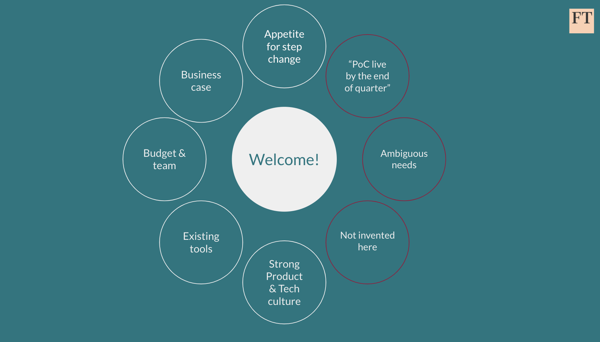
This last issue was a challenge given the size of the task, and there was already an idea that marketing automation was the answer. This may or may not have been the answer, but it was vital to step back and consider the overall strategy before deciding on the tech.
These are the components of the FT's martech strategy:
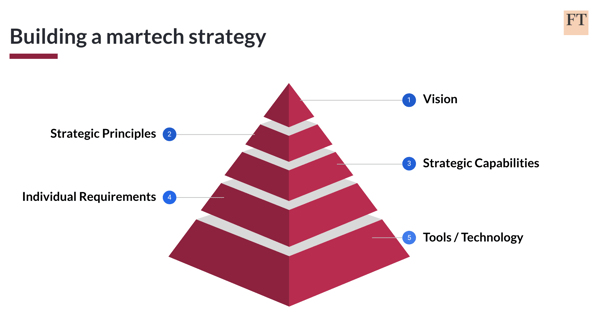 Essentially, before heading straight into step five and choosing tech, there are four other steps to go through, some of which may take time, but which ensure that the needs of different teams are considered and they arrive at step five in a good place to make the right decision.
Essentially, before heading straight into step five and choosing tech, there are four other steps to go through, some of which may take time, but which ensure that the needs of different teams are considered and they arrive at step five in a good place to make the right decision.
As Gregor explains, the various steps involved lots of meetings, discussions with stakeholders, workshops, discussions with vendors, gathering of requirements, and lots of listening.
Through these steps, he was able to identify individual requirements from different teams, and work towards agreeing strategic principles and defining a vision.
As Gregor these processes may take time but cannot be skipped:
"When you're developing this vision the steps of the process are super important. You cannot skip these things. But it's not necessarily where your vision is going to come from. You need a visionary. Now, that might be one person, it might be multiple people. It might be a marketer. It might be a product person or technology person. It might be an agency."
It's here that there can be a split between marketing and technology teams where marketing wants tech to find the tech they need, and tech teams need marketers to explain what they want.
This is the role of this visionary, to bridge this gap between the teams and help to define needs more clearly.
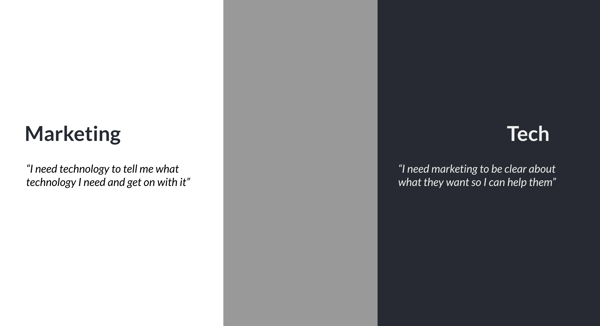
The principle that emerged was the idea of pivoting the approach to marketing campaigns. Rather than thinking about the tactic first, then message, then the choice of channel (mainly email), it was decided to change to a different way of thinking.
This new way would start with the customer and identifying their needs before deciding the most appropriate content or message, and delivering it to them through their channel of choice.
It's a simple concept, but it was an idea that unified and galvanised stakeholders, helping them to understand the complexity of the process.
And this is the vision statement that was arrived at, simple but an excellent principle to work from.
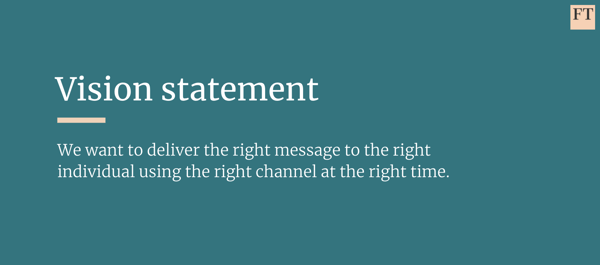
Once this principle was agreed, and the high level vision in place it was necessary to get into the detail. This was by way of a 38 page document:
I was trying to do was just bring a lot of these high level statements down to a much finer level of detail to make sure everyone actually really understood what we're actually saying. And what that really meant was everyone involved was much more informed and much more confident in what they were actually agreeing to."
This process helped to set out the strategy in detail, ensure agreement, and to define some of the strategic capabilities. So there was a clear thread from all the conversations to exactly why a tool or technology is needed.
We knew we needed a holistic customer profile, and that was well justified. We knew that we needed real time data, and so on. Instead of just throwing out buzzwords, we're reading from the manual, we fully justify what it is we're actually aiming for and now we can start talking about the detail of the technology.
Gregor makes a key point here: martech strategies are hard. They're hard because you're mixing marketers with technologists, and mixing cultures and skill sets.
This is why you need someone (a visionary) to bridge the gap, and to articulate the process in the required detail.
So at this point the FT has arrived where it thought it was a few months before: choosing the right tech.
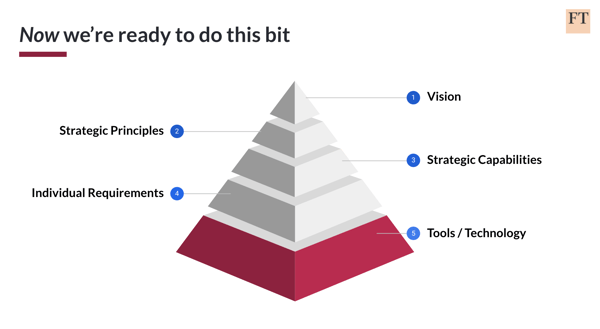
At this point the previous four steps, and the discussions and work that was necessary to complete then pays off.
We knew from our capabilities what we were targeting, and so we were able to easily and confidently go out into the market and find the right products. It just made it so much easier. This marketplace is hugely advanced, but that also means it's really complicated.
It's really hard to navigate, to actually know who to talk to, what kind of tools are needed, and what kind of vendor. But because we've gone through this process, we had a lot of confidence.
So, the FT arrived at the right place, thanks to this process. The team was able to make decisions with confidence , knowing the vision and principles behind its marketing strategy, its requirements and its current tech capabilities.
People have been involved throughout, stakeholders are onboard and feel involved, and tech teams have the detail they need to get on with the project.
As Gregor sums up: "There's nothing super complicated about this. We just did the process in the right kind of way with a happy project, and it's delivered pretty well ever since."
Our six week Essentials of Martech: The 4Ps of Marketing Technology training course begins in February 2022. Enrol now!
